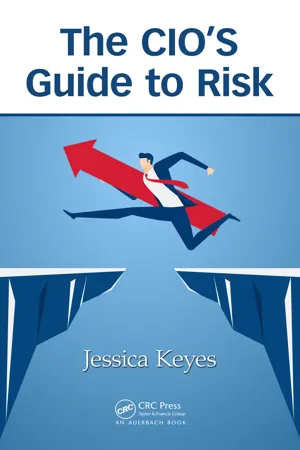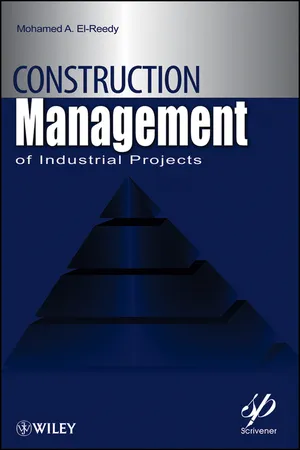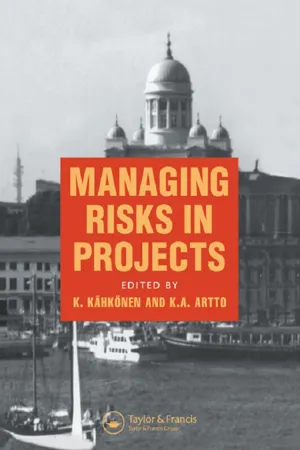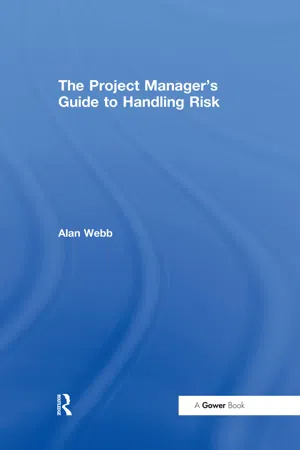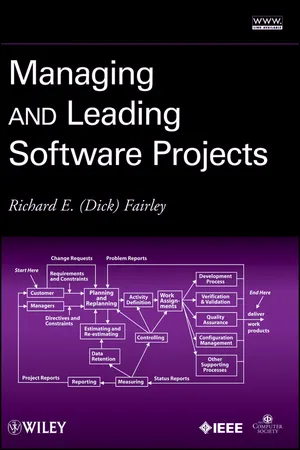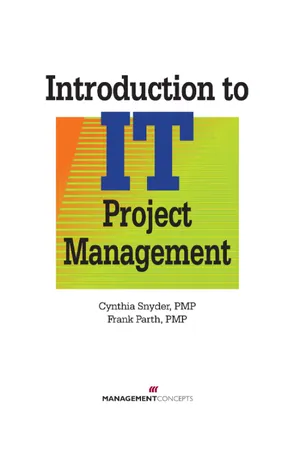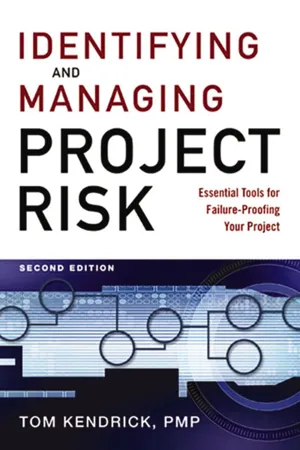Technology & Engineering
Project Risk Management
Project Risk Management involves identifying, assessing, and mitigating potential risks that could impact a project's success. It includes processes for analyzing and responding to risks throughout the project lifecycle. By proactively addressing uncertainties and potential issues, project teams can minimize the impact of adverse events and improve the likelihood of achieving project objectives.
Written by Perlego with AI-assistance
Related key terms
11 Key excerpts on "Project Risk Management"
- eBook - ePub
- John E. Triantis(Author)
- 2018(Publication Date)
- Wiley(Publisher)
CHAPTER 10 Project Risk ManagementCrucial for Project SuccessProject risk is the failure of a project to meet its objectives and the loss associated with it if a threat event materializes. For estimation purposes, it is the product of the probability of occurrence by the severity of the outcome. Risk is a part of business life and projects and when it happens it adversely impacts company strategies and project objectives. Project risks are not only of external but also of internal nature to both project sponsors and customers. Our focus is on external risks since the internal risks have already been identified by the sponsor and customer SWOT analysis and dealt with. International project finance deals entail a number of risks and a good deal of project success depends on effective risk management.Risk management is an integral part of managing a project and the larger the project, the more attention is directed to risk management, which requires support from the project team and the decision makers of stakeholder organizations. Effective risk management is a prerequisite to striving to attain competitive advantage in project finance and create successful deals. Risk management is the progression of identifying, analyzing, prioritizing, and mitigating risks to minimize their impact on project value creation. To get a sense of the type and frequency of risks materializing and stress the importance of risk management, Table 10.1 - eBook - ePub
- Triant G. Flouris, Dennis Lock(Authors)
- 2016(Publication Date)
- Routledge(Publisher)
For very large projects it might be necessary to appoint a risk manager, who can devote all or most of their time to ensuring that a comprehensive risk strategy is put in place and then reviewed from time to time throughout the project to ensure that it remains valid. If a project support office exists, that is a logical place for the risk management function to reside.Project Risk Management is a complex subject. Even the classification of risks is not straightforward and can be approached in different ways. There are several techniques for assessing and dealing with project risks, some of which are shared with other management disciplines (particularly with quality management and reliability engineering). This chapter will outline a few of the methods commonly used.IDENTIFYING THE POSSIBLE RISKS
It is almost certain that some tasks will not be completed in line with their duration estimates and budgets. Some might exceed their estimates, whilst others could be finished early and cost less than expected. As explained in the previous chapter, statistical tools such as PERT (see Chapter 7 ) and Monte Carlo analysis can be used to attempt an assessment of the probability of the project finishing by its target completion date or of the intended return on investment being realized. However, those measures deal with uncertainty rather than with risk. Risks are unforeseen (and often unforeseeable) events that can result in a change of project plans or even total project failure.Projects can incur risks from the ‘accident waiting to happen’ variety to the most unexpected and bizarre. Risks can materialize during project design and execution or after the project is finished and has been handed over to the customer.Management change and IT projects seem to be particularly prone to risk of failure, with huge losses of money, delay in completion, or malfunctions. Projects in the aviation industry appear to have been vulnerable to failure through IT problems. We mentioned the Airbus 380 project in this context in Chapter 1 (where design faults in the wiring harnesses have been attributed to collaborating manufacturers using different versions of CAD software). There have been many reported instances of problems with both on-board and ground computer systems. For example, chaos can result if a flight reservation and ticketing system malfunctions. Air traffic control systems appear to have been vulnerable, with malfunctions causing widespread grounding of flights and with obvious potential to cause flight hazards. The frequently updated website <http://www.lessons-from-history.com - eBook - ePub
- Jessica Keyes(Author)
- 2017(Publication Date)
- Auerbach Publications(Publisher)
2 Information Technology Project RiskWe will examine the concept of project risk, with careful attention paid to the mitigation of risks. We will examine the different varieties of risks (e.g., business, environment, product, employee) learn how to apply probability to each risk, understand the impact of each risk, and ultimately learn how to devise a contingency plan for each risk.
Project Risk Management addresses the following questions:The Proactive Risk Strategy- Are we losing sight of goals and objectives as the project moves forward?
- Are we ensuring that the results of the project will improve the organization’s ability to complete its mission? The result should be an improvement over the previous process.
- Are we ensuring sufficient funds are available, including funds to address risks?
- Are we tracking implementation to ensure “quicker/better/cheaper” objectives are being met?
- Are we applying appropriate risk management principles throughout the project?
- Are we taking corrective action to prevent or fix problems, rather than simply allocating more money and time into them?
- Have changes in the environment, such as new IT systems or leadership, created new risks that need to be managed?
A proactive risk strategy should always be adopted, as shown in Figure 2.1 . It is better to plan for possible risk then have to react to it in a crisis.Figure 2.1 Risk management feedback loop.Sound risk assessment and risk management planning throughout project implementation can have a big payoff. The earlier a risk is identified and dealt with, the less likely it is to negatively affect project outcomes. Risks are both more probable and more easily addressed early in a project. By contrast, risks can be more difficult to deal with and more likely to have significant negative impact if they occur later in a project. As explained later, risk probability is simply the likelihood that a risk event will occur. Conversely, risk impact is the result of the probability of the risk event occurring plus the consequences of the risk event. Impact, in laymen’s terms, is telling you how much the realized risk is likely to hurt. - eBook - ePub
Identifying and Managing Project Risk 4th Edition
Essential Tools for Failure-Proofing Your Project
- Tom Kendrick(Author)
- 2024(Publication Date)
- AMACOM(Publisher)
chapter 13 .) In firms that provide solutions to customers, using a defined methodology can be a strong competitive advantage that can help win business. In some organizations, evidence of process maturity is deemed important, so they aspire to standards for higher maturity using structures such as the Capability Maturity Models defined by the Software Engineering Institute. In other instances, specific process requirements may be tied to the work, as with many government contracts. Many industries and disciplines have strict regulations mandating specific processes, such as finance, biotech, and pharmaceuticals. In all of these cases, aspects of formal project management are mandatory, regardless of the opinions of individuals and managers.The Project Management Methodology
Project Risk Management depends on thorough, sustained application of effective project management principles. While the precise nature of project management methodologies varies widely, managing risk tends to be most successful with consistent organization-wide processes. Common practices provide both additional useful data to work with and more durable support for the ongoing effort required. If you find it impossible to gain support for more effective project management principles broadly, at least resolve to apply them with sufficient rigor to your projects to help you manage your risks.DEFINING RISK MANAGEMENT FOR THE PROJECT
In addition to basic project planning, effective risk management also involves its own specific planning. Risk planning begins by reviewing the initial project assumptions. Project charters, datasheets, or other documents used to initiate a project often include information concerning risk, as well as overall goals, staffing assumptions, and other information. Any risk information included in these early project descriptions is worth noting; sometimes projects believed to be risky are described as such, or there may be other evidence of project risk. Projects believed to be low risk often involve assumptions leading to unrealistically low staffing and funding. Take note of any differences in your perception of project risk and the stated (or implied) risks perceived by the project sponsors and other initiators. In particular, work to understand the expectations of the project stakeholders, and adopt an approach to risk management consistent with their expectations. - eBook - ePub
Construction Management for Industrial Projects
A Modular Guide for Project Managers
- Mohamed A. El-Reedy(Author)
- 2012(Publication Date)
- Wiley-Scrivener(Publisher)
Chapter 9Project Risk Management
9.1 Introduction
Earlier in Chapter 3, risk assessment was discussed from the standpoint of the overall economic prospects, positive and negative, of a project proposal. This chapter discusses how to define, control, and mitigate risks that emerge during project execution.When studying risk assessment for a project from an economic point of view, the probabilistic studies and Monte-Carlo simulation techniques are key in this assessment, which is called quantitative risk assessment. But this method of analysis and assessment requires special software with specialized skills. On applying risk assessment in the execution phase using qualitative risk assessment tools, as we will describe in detail in this chapter. This assessment method is not required a special skills or software. Risk management during project execution is a combination of experience and qualitative skills, deployed usually by a team involved in the project’s execution, led by someone experienced in qualitative risk assessment strategies from other similar projects. One of the greatest sources of risk to be managed is poor, shoddy or otherwise inadequate execution of some programmed task(s) whose correction will increase project costs, time or overall output quality.Risk potential is less at the end of the project than at the outset. The risks can be classified in two categories:- Project risks are the risks that can happen during a project due to technical mistakes that can occur during construction.
- Process risks are the risks that can occur during the project due to procedural mistakes, poor communication between the project team, or poor team performance.
In general, there are many sources of uncertainties, especially in the main elements of a project, which are cost, time, quality, and HSE as presented in Figure (9.1) - eBook - ePub
- K.A. Artto, K. Kahkonen(Authors)
- 2013(Publication Date)
- Spon Press(Publisher)
2. Project Risk Management - definitions and tools
There are several project management standards that provide a definition of Project Risk Management. The Project Risk Management content defined according to Project Management Institute’s (PMI) definition is shown in Fig. 1 [1]. Risk management content is also reported in recent documentation for the project management quality guideline ISO [2] that recognize following risk related processes:• risk identification • risk estimation • risk response development • risk controlFig. 1. Risk management overview (according to [1])The ISO [2] definition about risk management content above is similar to that of PMI’s, and in general, risk management literature defines risk management in similar manner. In some contexts, the terms risk analysis or risk appraisal are used to refer to the first stages of identification and estimation and quantification.In project companies, there are risk response sheets in use as empirical tools that are designed to guide identification, estimating, and risk response planning. The structure of those sheets in use usually is consistent with the standards (cf. [1] and [2] referred to above). A hypothetical and simplified presentation of a risk management sheet visualising a tool used in several Finnish project companies is depicted in Fig. 2 .Fig. 2. A risk management sheet as a visualisation about empirical tools in use3. Historical perspective - risk management of the 80’s
3.1. Quantitative and risk analysis oriented risk management in the 80’s
In the beginning of the 80’s, Project Risk Management was a well recognized area in project management literature. The content consisting of risk identification, estimation, risk response development and risk control was generally known. In the discussion of risk management at that time, quantitative risk analysis was emphasized. For example, the stochastic three point estimate features of the PERT methodology vere widely referred to. The PERT methodology with a probabilistic interpretation of optimistic, pessimistic and most probable value estimates has its origin in developing the PERT methodology in the 50’s. - eBook - ePub
COSO Enterprise Risk Management
Establishing Effective Governance, Risk, and Compliance Processes
- Robert R. Moeller(Author)
- 2011(Publication Date)
- Wiley(Publisher)
Essentially every project effort, whether IT, production, financial, or any of many other areas will have some degree of risk-related potential issues in each of these areas. The responsible project manager needs to understand the interactions and any risks associated with each of these areas. Exhibit 14.6 Integrating Project Risk with Other Management Functions This concept of project risk and the values to be gained from a project over the various phases of the project's development life are important. The overall ERM framework has been described as a continuous but changing and ever-adapting process in the overall enterprise. The enterprise will manage a given risk situation, may adapt its processes to work with risks in a subsequent period, and will go on and on in that manner. A project is a fixed duration endeavor that will go through a series of fairly consistent phases until the termination of the project and, hopefully, the delivery or completion of the planned project outputs. With this limited time period duration, Project Risk Management is even more important. Exhibit 14.7 shows this level of risk over the life of a project. Any project will go through a series of initial planning and development steps and then will move to development and implementation phases. As Exhibit 14.7 shows, some of the highest project risks will be in the earliest phases of the project life cycle where developers face the risks of making some initial planning blunders regarding the project. However, as a project moves from planning and development to implementation, its costs and time constraints will increase. Thus, an individual project effort will face its highest risk during the implementation phase when many risks are still in place but have been covered and costs are increasing - eBook - ePub
- Alan Webb(Author)
- 2017(Publication Date)
- Routledge(Publisher)
Suitable conditions must be created within both the project organization and the information system for risk issues to identified, monitored and suitable actions taken. Risk management goes well beyond setting up a structure - it is an ongoing process that needs to be carried out throughout the life of the project. Different responses to the risks and opportunities that present themselves will have to be adopted according to the stage of the project and the state of development of the end product. Figure 8.2 shows a schematic process for risk management together with the techniques appropriate to each situation in the risk management process. Risk identification At the start it is important to understand the fundamental objectives of the project; these might typically include making a worthwhile return on the venture. However, projects are not simply speculative investments in finance, in order to achieve that return some work must be done and it is in that process that most of the risks lie. It is therefore important to identify the sources of risk within the activities of the project; this may be a rather subjective process but a structured and analytical approach, whilst not eliminating the subjective element, can at least ensure completeness. Specific techniques that are generally applicable and simply implemented include: Figure 8.2 The risk management process and associated techniques. The formulation of checklists based on experience of earlier projects - Risk issues can be identified through an examination of what occurred on previous projects plus an overall understanding of the issues that are likely to be problematic on future projects. These issues can be formalized into lists and structured in a way that suits the particular type of project. New projects can then be examined against the list and an opinion formed about each point raised. Structured interviews with responsible or knowledgeable staff, perhaps using the checklist as a basis - eBook - ePub
- Richard E. Fairley(Author)
- 2011(Publication Date)
- Wiley-IEEE Computer Society Pr(Publisher)
Appendix 9B to this chapter and in [Fairley05].Additional terms used in this chapter and throughout this text are defined in the Glossary at the end of the text. Presentation slides for this chapter and other supporting material are available at the URL listed in the Preface.9.3 AN OVERVIEW OF RISK MANAGEMENT FOR SOFTWARE PROJECTS
Software projects are inherently risky endeavors because achieving a successful outcome (i.e., delivering an acceptable product on time and within budget) involves establishing and maintaining a balance among many technical, organizational, social, and political constraints, any or all of which may change as a project evolves. Each potential problem for a software project is called a risk factor because it represents a threat to a successful outcome. Table 9.2 lists some commonly occurring kinds of risk factors for software projects.The risk of inadequate calendar time may result from:- committing to a bad estimate,
- customer or management compression of a schedule without a corresponding adjustment to resources and/or requirements,
- addition of requirements without corresponding adjustments to schedule and resources, or
- reduction in planned resources without corresponding adjustments.
The risk of insufficient funds to conduct a project may involve lack of enough money in the budget to carry out all of the necessary work activities (perhaps caused by a bad estimate or by agreeing to a “mandated” budget), or it may involve not receiving the money in a timely manner. In the latter case, for example, the customer who is paying for a project may delay incremental payment of funds or your management may defer allocation of needed funds until next fiscal quarter or fiscal year.Lack of adequate requirements management can create may different kinds of potential and real problems. As indicated in Table 9.2 - eBook - ePub
- Cynthia Snyder PMP, Frank Parth PMP(Authors)
- 2006(Publication Date)
- Berrett-Koehler Publishers(Publisher)
• IT projects have five overall sources of risk: team members, technology, project management, the organization, and external factors. Team member risks include skills and availability. Technical risks are comprised of technology, approach, and the technical environment. Project management risks include scope, schedule, budget, and the project management aspects of the project. Organizational risks are made up of the structure and culture of the organization. External risks are those risks that are outside of the control of the project manager, including risks external to the project and the organization.• To identify risks, the project manager should review project documentation, conduct interviews, use checklists, and/or create a risk breakdown structure (RBS). An RBS is a source-oriented grouping of project risks that organizes and defines the total risk exposure of the project. It allows the team to identify risks in a structured fashion.• To complete the process of risk identification, the project manager should create risk statements and enter them into a risk register.• Analyzing project risks entails estimating the probability that a risk will occur and the impact if it does occur. A matrix of high, medium, and low probability and impact is used to analyze risks. A risk event can impact on the scope/performance/quality, the schedule, the budget, and stakeholder satisfaction.• Tools for risk analysis include a preliminary risk analysis that considers the size, technology, and project management structure; a probability-impact matrix; and a project risk-profile form. • Risk responses include avoiding the risk, mitigating the risk, transferring the risk, and accepting the risk.• Contingency plans are put in place to deal with the risk if it occurs. Risk triggers alert the project manager that a risk has occurred or is about to occur. Secondary risks are risks that are the result of a risk response strategy. Residual risks are those risks that are left after the risk response is developed. Sometimes schedule or budget reserve can be used to reduce risk to the project. A fallback plan is used if the risk response does not work and the risk occurs. - eBook - ePub
- Tom Kendrick(Author)
- 2009(Publication Date)
- AMACOM(Publisher)
For example, the target schedule for a risky project might be twelve months, but the committed schedule, reflecting potential problems, may be set at fourteen months. Completion within (or before) this range defines a successful project; only if the project takes more than fourteen months will it be considered a failure. Project risk assessment data provides both the rationale and the magnitude for the required reserve. More on this is found in Chapter 10. Project Communication and Control Project communication is most effective when there is a solid, credible plan. Risk assessments also build awareness of project exposures for the project team, showing when, where, and how painful the problems might be. This causes people to work in ways that avoid project difficulties. Risk data can also be useful in negotiations with project sponsors. Using information about the likelihood and consequences of potential problems gives project leaders more influence in defining objectives, determining budgets, obtaining staff, setting deadlines, and negotiating project changes. The Project Risk Management Process The overall structure of this book mirrors the information in the Guide to the Project Management Body of Knowledge (or PMBOK ® Guide). This guide from the Project Management Institute (PMI) is widely used as a comprehensive summary of project management processes and principles, and it is the foundation for PMI certification. The PMBOK ® Guide has nine Project Management Knowledge Areas: 1. Project Integration Management 2. Project Scope Management 3. Project Time Management 4. Project Cost Management 5. Project Quality Management 6. Project Human Resource Management 7. Project Communications Management 8. Project Risk Management 9
Index pages curate the most relevant extracts from our library of academic textbooks. They’ve been created using an in-house natural language model (NLM), each adding context and meaning to key research topics.


